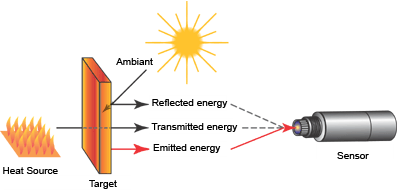Emissivity is the measure of an object's ability to emit infrared energy. Emitted energy indicates the temperature of the object. Emissivity can have a value from 0 (shiny mirror) to 1.0 (blackbody). Most organic, painted, or oxidized surfaces have emissivity values close to 0.95. Majority of Fluke Process Instruments sensors have adjustable emissivity feature to ensure accuracy when measuring other materials such as shiny metals. Our applications engineers can assist you in choosing the most efficient IR sensor for your target material emissivity, temperature range and type of application.

If you are using a sensor with a fixed, preset emissivity of 0.95, and need to measure a shiny object you can compensate by covering the surface to be measured with spray oil, flat black paint or masking tape. Measure the temperature of the taped or painted surface. That is the true temperature.